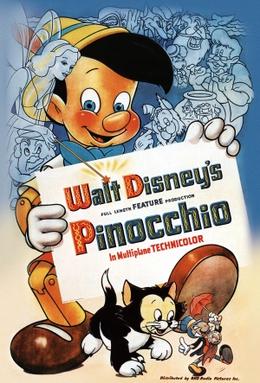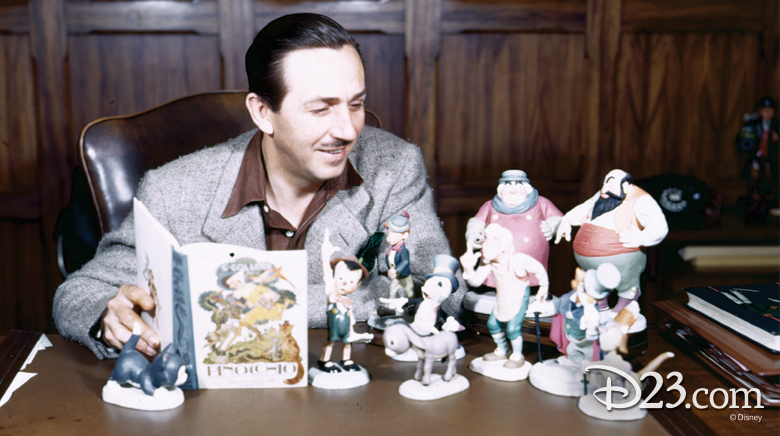
The second film in the Disney Animated Canon, made concurrently with Snow White. It’s also one of the darkest films of the Disney Animated Canon as well, leaps and bounds ahead of Snow White, being made in two years instead of four.
PLOT –
When elderly toymaker Geppetto (Christian Rub) wishes upon a star, a Blue Fairy (Evelyn Venable) brings his just-designed puppet Pinocchio (Dickie Jones) to life. Guided by Geppetto and his newly appointed conscience Jiminy Cricket (Cliff Edwards), Pinocchio sets off to school to become brave, truthful, and unselfish so he can become a real boy. However, he falls victim to the wiles of conman Honest John (Walter Catlett), who takes Pinocchio to meet puppet-master Stromboli (Charles Judels), as well as visit Pleasure Island, a theme park with no rules.
The plot mainly focuses on Pinocchio instead of having side-plots, aside from the parallel character growth of cricket and puppet. It is more streamlined than its predecessor, and the film’s momentum is fast-paced, never staying in one location for too long. There is a lack of resolution to characters though, and they come and go in the film almost at will. Some plot points come out of thin air, almost literally, and other parts rely on plot contrivances and conveniences to allow the story to continue.
My PLOT Rating is 6 / 10 (3 / 5).
CHARACTERS –
Just like Snow White, there are a lot of characters to cover in this film. In particular, however, they are also metaphors for relationships, or psychological concepts. For example: the “Self” Ego (Pinocchio), the “conscience” Super-Ego (Jiminy, Geppetto, Blue Fairy), and the “animalistic” Id (the Antagonists and Lampwick).
Pinocchio (Dickie Jones) is pure innocence, expertly played without thought, just natural reactions all around. He is the “audience insert character” that we all can see as ourselves. Something I especially love about Pinocchio is that he finally gains his own agency and goes after his father immediately after learning of his capture. Throughout the movie he learns and grows to be mentally more human, and finally gains self-agency without the prompting of other characters. It can be argued that this happens during the transformation scene, but doing the right thing is something that Pinocchio thankfully learns by the end.
Geppetto (Christian Rub) is the father figure and sympathetic character of the film. He teaches Pinocchio some basic life lessons, even accidentally teaching him the danger of fire (in a nice bit of foreshadowing), but all of this comes from love. He is a single parent now, and it’s interesting that this film portrays this stable relationship between father and son, how he wants him to grow and become a productive member of society. It’s incredibly heartwarming.
Jiminy Cricket (Cliff Edwards) is a Disney staple. An icon. He is the conscience of the film. He has more contemporary dialogue in the film, and he isn’t a perfect character. In fact, he is first seen breaking into Geppetto’s Workshop to stay the night! His flaws and imperfections in the film only heighten his character though, and place him at the same level as an adult taking care of a child and feeling like they are not strong enough to at points. Jiminy takes a backseat for some of the film, watching over Pinocchio and guiding him while letting the puppet make his own decisions. Later on, he stops becoming his guide, and becomes the puppet’s friend, supporting him physically as well as spiritually.
The Blue Fairy (Evelyn Venable) is another good-mannered character. She is more of a plot device than a character, though, and she shows up a few times to teach lessons or help Pinocchio out of situations he or Jiminy cannot fix. What I must say is that she is animated with more life and movement than Snow White, the Prince, or the Queen ever were in such a short time onscreen.
Honest John (Walter Catlett) and Gideon (Mel Blanc, but only for a single hiccup) are comic relief villains. The fox and the cat are con artists. They prey on young children, taking them away from school, and act as the analogy of temptation, that first thought of doing something bad entering your mind. They are humorous characters that reappear midway into the film, and as a result, are the most memorable villains from the film. Sure, they are funny characters featuring some vaudeville slapstick, but they are the start of the evil that is to come.
Stromboli (Charles Judels) is a textbook abuser. He is the epitome of toxic relationships. He treats you nice and lures you in however he can, through kindness, the promise of being loved, money… Then, when he gets what he wants, he stops being nice. He keeps you where he can see you. He threatens you, he abuses you, he uses you. The character always has this trait slinking below the surface, ready to be let out, and the audience can see it, but the characters within the film cannot. And that is the scariest part.
The Coachman (Charles Judels) is even worse. He is outwardly evil from the get go, and doesn’t really have to hide it. His analogy is of the businessman, willing to get profits by any means, with a shadowy crew, and physically abusive, similar to Stromboli. He has a frightening face that he puts on for a moment, but that face will stick in the minds of many. He’s a great villain and more of a realistic evil than most Disney Villains.
The worst part about the previous characters is that they all get away with their misdeeds. Stromboli gets the worst of it, not having a headliner anymore, but John, Gideon, and the Coachman get off scot free, most likely continuing to turn kids into foals.
Lampwick (Frankie Darro) is the example character, showing what will happen to Pinocchio if he continues along this path. Lampwick’s role ends in tragedy; he doesn’t see that his behavior is like his name – burning the candle at both ends. He’s rude, snide, and has zero respect for authority. His candle does go out, and his transformation sequence is the most horrifying scene in the Disney Animated Canon, even now.
Monstro is a final challenge, and literally an animal, but in this case talking would lessen the threat. He is the true Id of the film, and more of a reactive villain than a proactive one. We come upon him as he sleeps, and he is only woken by the fire started from within his mouth, becoming angered and sneezing to let Pinocchio and his family escape. he is the only character to get any sort of visual comeuppance, but he’s just an animal justifiably acting the way animals do. In the story, he has built up a reputation for swallowing boats whole, so while this may make him a villain in the eyes of some, Monstro is more a force of nature than a good-or-evil allied character.
My CHARACTERS Rating is 10 / 10 (5 / 5).
DIALOGUE –
The dialogue is more modern than its predecessor, and characters talk to each other more. Exposition is delivered more handily, and some dialogue hides future plot points between the lines. It’s simple dialogue but clean and clearly effective. One of my few regrets about the dialogue in the film is that some characters did not meet or interact. It would have been interesting to have Jiminy meet Geppetto, or even have Stromboli meet the Coachman.
My DIALOGUE Rating is 8 / 10 (4 / 5).
EFFECTS –
The lighting effects at the beginning of the film are breathtaking. Everything is done by hand in this film without the aid of computers, and this film looks brilliant. The water in the film is gorgeous as well, on the surface and beneath, complete with vocal modifications to indicate speech underwater. The transformation scene also provides beautiful(ly horrifying) animation as well.
My EFFECTS Rating is 10 / 10 (5 / 5).
MUSIC –
“When You Wish Upon a Star” is in a category all it’s own. Perfection.
“Little Wooden Head” is Christian Rub’s only song, but it’s adorable, and reflects a sort of improvised style that someone would have making up a song when no one’s around.
“Give a Little Whistle” is cute and fun, with a lot of vocal improv and sound effects. It utilizes several unconventional sound effects. It is somewhat repetitive though, but effective in its meaning and message.
“Hi Diddle Dee Dee” is the Anti-“Give a Little Whistle”, and is fun to sing, but on purpose. Again, it is repetitive, but it’s designed to get into your head and affect your mentality.
“I’ve Got No Strings” is the showstopper of the film. It starts out slow with Jones singing, but picks up speed as it goes along. It includes several stanzas by other singers, and a fast-paced climax. Lacking somewhat in lyrics, but powerful in momentum.
The score is effective in each scene, heightening the mood wherever needed.
My MUSIC Rating is 10 / 10 (5 / 5).
OVERALL –
What a gorgeous and horrifying film. This probably Disney at it’s consistently scariest. There are several heartwarming moments though, and it balances out somewhat. Excellent characters, effects, and music, pretty good dialogue with a plot that relies on a few conveniences to get by.

My OVERALL Rating is 88%.
Join us next time where we play a lot of classical music and struggle to come up with visuals for it.
The most concise summary and detailed description of this classic (and beloved) Disney classic. Your insight and clarity is spot on. Thank you! You are a quite a talented writer and critic. Looking forward to the next one….
LikeLike